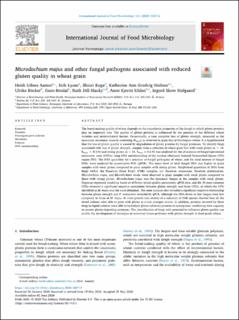| dc.contributor.author | Aamot, Heidi Udnes | |
| dc.contributor.author | Lysøe, Erik | |
| dc.contributor.author | Koga, Shiori | |
| dc.contributor.author | Nielsen, Katherine Ann Gredvig | |
| dc.contributor.author | Böcker, Ulrike | |
| dc.contributor.author | Brodal, Guro | |
| dc.contributor.author | Dill-Macky, Ruth | |
| dc.contributor.author | Uhlen, Anne Kjersti | |
| dc.contributor.author | Hofgaard, Ingerd Skow | |
| dc.date.accessioned | 2020-10-12T12:12:02Z | |
| dc.date.available | 2020-10-12T12:12:02Z | |
| dc.date.created | 2020-06-23T09:02:57Z | |
| dc.date.issued | 2020-06-02 | |
| dc.identifier.issn | 0168-1605 | |
| dc.identifier.uri | https://hdl.handle.net/11250/2682254 | |
| dc.description.abstract | The bread-making quality of wheat depends on the viscoelastic properties of the dough in which gluten proteins play an important role. The quality of gluten proteins is influenced by the genetics of the different wheat varieties and environmental factors. Occasionally, a near complete loss of gluten strength, measured as the maximum resistance towards stretching (Rmax), is observed in grain lots of Norwegian wheat. It is hypothesized that the loss of gluten quality is caused by degradation of gluten proteins by fungal proteases. To identify fungi associated with loss of gluten strength, samples from a selection of wheat grain lots with weak gluten (n = 10, Rmax < 0.3 N) and strong gluten (n = 10, Rmax ≥ 0.6 N) was analyzed for the abundance of fungal operational taxonomic units (OTUs) using DNA metabarcoding of the nuclear ribosomal Internal Transcribed Spacer (ITS) region ITS1. The DNA quantities for a selection of fungal pathogens of wheat, and the total amount of fungal DNA, were analyzed by quantitative PCR (qPCR). The mean level of total fungal DNA was higher in grain samples with weak gluten compared to grain samples with strong gluten. Heightened quantities of DNA from fungi within the Fusarium Head Blight (FHB) complex, i.e. Fusarium avenaceum, Fusarium graminearum, Microdochium majus, and Microdochium nivale, were observed in grain samples with weak gluten compared to those with strong gluten. Microdochium majus was the dominant fungus in the samples with weak gluten. Stepwise regression modeling based on different wheat quality parameters, qPCR data, and the 35 most common OTUs revealed a significant negative association between gluten strength and three OTUs, of which the OTU identified as M. majus was the most abundant. The same analysis also revealed a significant negative relationship between gluten strength and F. avenaceum detected by qPCR, although the DNA levels of this fungus were low compared to those of M. majus. In vitro growth rate studies of a selection of FHB species showed that all the tested isolates were able to grow with gluten as a sole nitrogen source. In addition, proteins secreted by these fungi in liquid cultures were able to hydrolyze gluten substrate proteins in zymograms, confirming their capacity to secrete gluten-degrading proteases. The identification of fungi with potential to influence gluten quality can enable the development of strategies to minimize future problems with gluten strength in food-grade wheat. | en_US |
| dc.language.iso | eng | en_US |
| dc.publisher | Elsevier B.V. | en_US |
| dc.rights | Navngivelse 4.0 Internasjonal | * |
| dc.rights.uri | http://creativecommons.org/licenses/by/4.0/deed.no | * |
| dc.title | Microdochium majus and other fungal pathogens associated with reduced gluten quality in wheat grain | en_US |
| dc.type | Peer reviewed | en_US |
| dc.type | Journal article | en_US |
| dc.description.version | publishedVersion | en_US |
| dc.rights.holder | © 2020 The Authors | en_US |
| dc.source.volume | 331 | en_US |
| dc.source.journal | International journal of food microbiology | en_US |
| dc.identifier.doi | 10.1016/j.ijfoodmicro.2020.108712 | |
| dc.identifier.cristin | 1816691 | |
| dc.relation.project | Norges forskningsråd: 294651 | en_US |
| dc.relation.project | Norges forskningsråd: 194051 | en_US |
| dc.relation.project | Norges forskningsråd: 233993 | en_US |
| cristin.ispublished | true | |
| cristin.fulltext | original | |
| cristin.qualitycode | 2 | |

